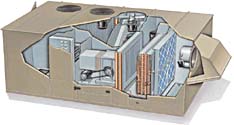“Applications where the air within a building or room cannot be recirculated, or where an HVAC system does not have the means for introducing fresh outside air, are good candidates for makeup air units,” said Mary Milmoe, vice president of marketing, Carrier North America Commercial, Carrier Corp., Syracuse, NY. “The decision to use makeup air units (over packaged rooftop units) to heat, ventilate, cool, humidify, dehumidify, and filter is mostly application driven.
“A rooftop unit’s use of recirculated air can provide tremendous energy savings when compared with the cost of constantly treating new, 100% outdoor air through a makeup air unit,” she said. “However, there are certain HVAC applications in which a rooftop unit is not suitable, where makeup air units just make sense.”

WHERE MAKEUP MAKES SENSE
As HVAC system design becomes more high tech and indoor air quality goes to the top of the list of concerns from building owners and managers, the need for a mechanical system that efficiently moves and conditions indoor air is more vital.“The ventilation requirement for buildings has placed an extra burden on the design of the HVAC system,” said Jeff Moe, manager, Commercial Unitary Product Support, Trane, Clarksville, TN. “When the system is incorporating unitary DX products and precise temperature or humidity control are required, standard system types are pushed to the limit of their usable, cost-effective operating envelope.
“In these cases, dedicated outdoor air [OA] units are necessary to maintain desired conditions at acceptable temperature and humidity tolerances.”
TYPICAL APPLICATIONS
Milmoe described some typical applications for makeup air units.“These units are often found in water-source heat pump HVAC applications, where buildings are being zoned for multiple tenants,” she said. “Building owners find the advantages of zoned energy efficiency [with demand-controlled ventilation], individual tenant comfort, and possible direct tenant billing very attractive.
“Makeup air units are often added to introduce fresh air into the zones, which the heat pump is incapable of doing on its own.
“Makeup air units are also commonly found in applications where a structure’s interior requires the constant introduction of 100% outside air and the existing interior air cannot be recirculated,” Milmoe said. “Hospital operating suites, restaurant kitchens exhaust systems, and manufacturing paint booths are good examples of makeup air unit applications.”
Just because makeup air units are often associated with the fit and function of rooftop units, it doesn’t necessarily follow that makeup air units are located on the roof. “In some applications, like in the hospital mentioned before, the makeup air unit may actually be housed within a mechanical room instead of on the building’s roof,” said Milmoe.
A number of variables go into makeup air unit/system design. Moe said it is important that customers are aware of what goes into each design.
“Conventional system design has assumed a cost per square foot of space,” he said. “That was historically based on standard unitary equipment and little to no outside air. When the system ventilation requirements demand a dedicated OA unit, the cost per square foot will increase.
“The owner needs to be educated that the HVAC budget must reflect these facts and requirements. This is the challenge for the engineer/contractor/manufacturer. Of course, tradeoffs can be made. Competing system types can be analyzed.”
Manufacturers like Trane and Carrier make and sell makeup air units, which are designed to meet the design needs of the market — but an educated customer needs to be a part of that design.
“There is no free lunch,” Moe said. “There are still first-cost and operating-cost considerations. Almost all of our product offerings can, and have been, used for makeup air duty. [But] the suitability of these units to their intended makeup air requirement needs to be closely scrutinized.”
Publication date: 09/16/2002




